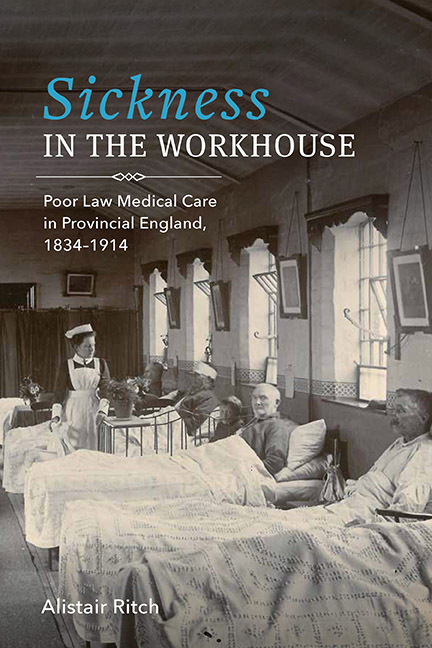Book contents
- Frontmatter
- Dedication
- Contents
- List of Tables
- Acknowledgments
- Introduction: Pauperism and Sickness
- 1 From Acute Illness to Chronic Disability
- 2 Segregating Fever Patients
- 3 Controlling Disorderly Behavior
- 4 Day-to-day Doctoring
- 5 Medical Therapies
- 6 Poor Law Nursing
- 7 “Every Care and Kindness”: The Standard of Workhouse Medicine
- Appendix A Prevalence of Selected Infectious Diseases in Birmingham Workhouse on the Last Day of the First Week of Each Quarter for the Years 1877–80 and 1894–1911
- Appendix B Medical Relief in Birmingham Workhouse for Selected Weeks, 1851–56
- Appendix C List of Drugs Kept in the Wards of Birmingham Infirmary in 1896
- Appendix D Pauperism Rates and Institutionalization Rates for Birmingham Parish, Wolverhampton Union, and England and Wales, 1840–1911
- Notes
- Bibliography
- Index
- Frontmatter
- Dedication
- Contents
- List of Tables
- Acknowledgments
- Introduction: Pauperism and Sickness
- 1 From Acute Illness to Chronic Disability
- 2 Segregating Fever Patients
- 3 Controlling Disorderly Behavior
- 4 Day-to-day Doctoring
- 5 Medical Therapies
- 6 Poor Law Nursing
- 7 “Every Care and Kindness”: The Standard of Workhouse Medicine
- Appendix A Prevalence of Selected Infectious Diseases in Birmingham Workhouse on the Last Day of the First Week of Each Quarter for the Years 1877–80 and 1894–1911
- Appendix B Medical Relief in Birmingham Workhouse for Selected Weeks, 1851–56
- Appendix C List of Drugs Kept in the Wards of Birmingham Infirmary in 1896
- Appendix D Pauperism Rates and Institutionalization Rates for Birmingham Parish, Wolverhampton Union, and England and Wales, 1840–1911
- Notes
- Bibliography
- Index
Summary
The nature of medical care in workhouses and of the clinical treatment inmates received after the New Poor Law is not well understood. Neither is it certain how representative it was of nineteenth-century therapeutics. This chapter analyzes the therapies that medical officers utilized in the management of patients in Birmingham and Wolverhampton workhouses and attempts to reconstruct the treatments they prescribed. Because workhouse medical officers were often required by boards of guardians to pay for the drugs they used from their salaries, historians have accused them of withholding effective treatment. Joseph Rogers recounts that, when he was appointed medical officer to Westminster workhouse in 1872, the retiring physician expressed pride in the fact that the only medicine he gave inmates was peppermint water. Was this true of other workhouses, or just an unrepresentative anecdote? At the beginning of the nineteenth century, medical treatment was much as it had been for many centuries, with the emphasis on depletive therapies, and it was not until the end of the century that the production of effective treatments in the form of the first vaccines for infectious diseases took place. However, from the perspective of twenty-first-century pharmacology, the only really effective drugs were opium and aperients, and the only one that could cure disease was, arguably, quinine for malaria. One advance in therapeutic technique was Edinburgh physician Alexander Wood's introduction of the hypodermic syringe for subcutaneous administration of drugs in 1855. Despite the lack of apparent ineffectiveness in the drug armamentarium, medical historians agree that nineteenth-century medical therapeutics worked in the context of the culture of the time and that patients had visible evidence of the effectiveness of the regimens employed.
Four approaches will be used to uncover therapeutic practice in the workhouses. First, therapies, such as natural and physical medical treatments, the use of food and alcohol as treatment for disease, and the drugs prescribed, will be described. Alcohol was an important and widely used therapy in the nineteenth century, but its prescription in workhouse infirmaries has not previously been investigated. An alternative approach to aid the understanding of therapeutic practice will investigate the management of specific conditions, such as respiratory disease and skin conditions. Third, the management of individual patients and their perspective on the treatment they received will be addressed through the complaints they made to the guardians.
- Type
- Chapter
- Information
- Sickness in the WorkhousePoor Law Medical Care in Provincial England, 1834–1914, pp. 154 - 186Publisher: Boydell & BrewerPrint publication year: 2019

